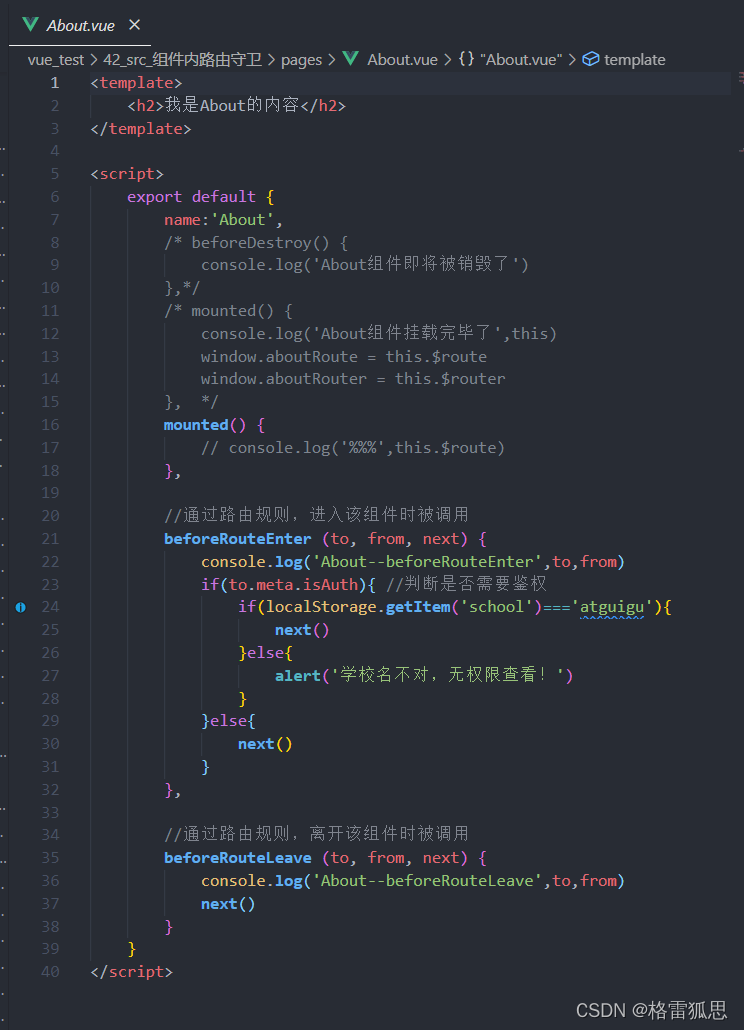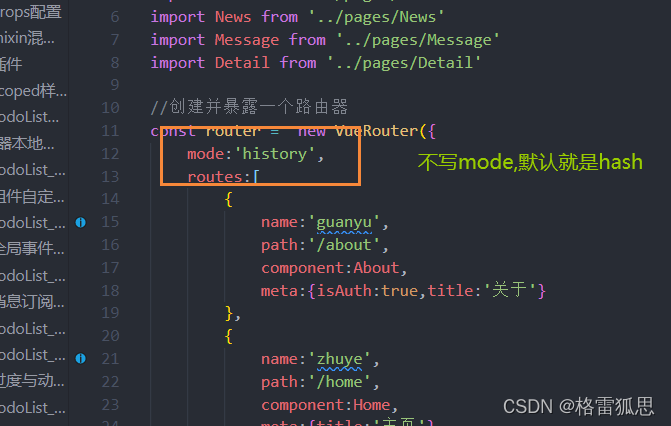4. 路由
-
-
理解: 一个路由(route)就是一组映射关系(key - value),多个路由需要路由器(router)进行管理。
-
前端路由:key是路径,value是组件。
-
对SPA应用的理解
(1)单页web应用(single page web application,SPA)
(2)整个应用只有一个完整的页面
(3)点击页面中的导航链接不会刷新页面,只会做页面的局部更新
(4)数据需要通过ajax请求获取
4.1 基本使用
(vue2用的router3版本,vue3用的是router4版本)
-
安装vue-router(router3版本),命令:npm i vue-router@3
-
应用插件:Vue.use(VueRouter)
-
编写router配置项:
//引入VueRouter
import VueRouter from 'vue-router'
//引入Luyou 组件
import About from '../components/About'
import Home from '../components/Home'
//创建router实例对象,去管理一组一组的路由规则
const router = new VueRouter({
routes:[
{
path:'/about',
component:About
},
{
path:'/home',
component:Home
}
]
})
//暴露router
export default router
4.实现切换(active-class可配置高亮样式)
<router-link active-class="active" to="/about">About</router-link>
5.指定展示位置
<router-view></router-view>
4.2 几个注意点
区分一般组件和路由组件
-
路由组件通常存放在pages文件夹,一般组件通常存放在components文件夹。
-
通过切换,“隐藏”了的路由组件,默认是被销毁掉的,需要的时候再去挂载。
-
每个组件都有自己的$route属性,里面存储着自己的路由信息。
-
整个应用只有一个router,可以通过组件的$router属性获取到。
4.3 嵌套路由(多级路由)
-
配置路由规则,使用children配置项:
routes:[
{
path:'/about',
component:About,
},
{
path:'/home',
component:Home,
children:[ //通过children配置子级路由
{
path:'news', //此处一定不要写:/news
component:News
},
{
path:'message',//此处一定不要写:/message
component:Message
}
]
}
]
2.跳转(要写完整路径):
<router-link to="/home/news">News</router-link>
3.指定展示位置
<router-view></router-view>
4.4 路由的query参数
-
传递参数
<!-- 跳转并携带query参数,to的字符串写法 -->
<router-link :to="/home/message/detail?id=666&title=你好">跳转</router-link>
<!-- 跳转并携带query参数,to的对象写法 -->
<router-link
:to="{
path:'/home/message/detail',
query:{
id:666,
title:'你好'
}
}"
>跳转</router-link>
2.接收参数:
$route.query.id
$route.query.title
4.5 命名路由
-
作用:可以简化路由的跳转。
-
如何使用
-
给路由命名:
{
path:'/demo',
component:Demo,
children:[
{
path:'test',
component:Test,
children:[
{
name:'hello' //给路由命名
path:'welcome',
component:Hello,
}
]
}
]
}
2.简化跳转:
<!--简化前,需要写完整的路径 -->
<router-link to="/demo/test/welcome">跳转</router-link>
<!--简化后,直接通过名字跳转 -->
<router-link :to="{name:'hello'}">跳转</router-link>
<!--简化写法配合传递参数 -->
<router-link
:to="{
name:'hello',
query:{
id:666,
title:'你好'
}
}"
>跳转</router-link>
4.6 路由的params参数
-
配置路由,声明接收params参数
{
path:'/home',
component:Home,
children:[
{
path:'news',
component:News
},
{
component:Message,
children:[
{
name:'xiangqing',
path:'detail/:id/:title', //使用占位符声明接收params参数
component:Detail
}
]
}
]
}
2.传递参数
<!-- 跳转并携带params参数,to的字符串写法 -->
<router-link :to="/home/message/detail/666/你好">跳转</router-link>
<!-- 跳转并携带params参数,to的对象写法 -->
<router-link
:to="{
name:'xiangqing',
params:{
id:666,
title:'你好'
}
}"
>跳转</router-link>
特别注意:路由携带params参数时,若使用to的对象写法,则不能使用path配置项,必须使用name配置!
3.接收参数:
$route.params.id
$route.params.title
4.7 路由的props配置
作用:让路由组件更方便的收到参数
{
name:'xiangqing',
path:'detail/:id',
component:Detail,
//第一种写法:props值为对象,该对象中所有的key-value的组合最终都会通过props传给Detail组件
// props:{a:900}
//第二种写法:props值为布尔值,布尔值为true,则把路由收到的所有params参数通过props传给Detail组件
// props:true
//第三种写法:props值为函数,该函数返回的对象中每一组key-value都会通过props传给Detail组件
props($route) {
return {
id: $route.query.id,
title:$route.query.title,
a: 1,
b: 'hello'
}
}
}
方便在要跳转去的组件里更简便的写法
跳转去组件的具体代码
<template>
<ul>
<h1>Detail</h1>
<li>消息编号:{{id}}</li>
<li>消息标题:{{title}}</li>
<li>a:{{a}}</li>
<li>b:{{b}}</li>
</ul>
</template>
<script>
export default {
name: 'Detail',
props: ['id', 'title', 'a', 'b'],
mounted () {
console.log(this.$route);
}
}
</script>
<style>
</style>
4.8 <router-link>的replace属性
-
作用:控制路由跳转时操作浏览器历史记录的模式
-
浏览器的历史记录有两种写入方式:分别为push和replace,push是追加历史记录,replace是替换当前记录。路由跳转时候默认为push
-
如何开启replace模式:<router-link replace .......>News</router-link>
<template>
<div>
<h2>我是Home的内容</h2>
<div>
<ul class="nav nav-tabs">
<li>
<router-link
replace
class="list-group-item"
active-class="active"
to="/home/news"
>News</router-link
>
</li>
<li>
<router-link
replace
class="list-group-item"
active-class="active"
to="/home/message"
>Message</router-link
>
</li>
</ul>
<router-view> </router-view>
</div>
</div>
</template>
<script>
export default {
name: "Home",
};
</script>
<style scoped>
</style>
4.9 编程式路由导航
-
作用:不借助<router-link>实现路由跳转,让路由跳转更加灵活(router-link转化成的事a标签)
-
具体编码:
//$router的两个API
this.$router.push({
name:'xiangqing',
params:{
id:xxx,
title:xxx
}
})
this.$router.replace({
name:'xiangqing',
params:{
id:xxx,
title:xxx
}
})
this.$router.forward() //前进
this.$router.back() //后退
this.$router.go() //可前进也可后退
Banner.vue
<template>
<div class="col-xs-offset-2 col-xs-8">
<div class="page-header"><h2>Vue Router Demo</h2></div>
<button @click="forward">前进</button>
<button @click="back">后退</button>
<button @click="test">测试一下go</button>
</div>
</template>
<script>
export default {
name: "Banner",
methods: {
forward() {
this.$router.forward();
},
back() {
this.$router.back();
},
test() {
this.$router.go(-2);
},
},
};
</script>
<style scoped>
button {
margin-right: 5px;
}
</style>
4.10 缓存路由组件
-
作用:让不展示的路由组件保持挂载,不被销毁。
-
具体编码:
这个 include 指的是组件名
<!--include的值代表要缓存的组件,比如下面代表在Home组件中要缓存News组件(组件名)-->
<!--如果要缓存多个路由组件就改写为:include="['News', 'Message']"-->
<keep-alive include="News">
<router-view></router-view>
</keep-alive>
4.11 两个新的生命周期钩子
作用:路由组件所独有的两个钩子,用于捕获路由组件的激活状态。 具体名字:
-
activated路由组件被激活时触发。
-
deactivated路由组件失活时触发。
这两个生命周期钩子需要配合前面的缓存路由组件使用(没有缓存路由组件不起效果)
News.vue
<template>
<ul>
<li :style="{ opacity }">欢迎学习vue</li>
<li>news001<input type="text" /></li>
<li>news002<input type="text" /></li>
<li>news003<input type="text" /></li>
</ul>
</template>
<script>
export default {
name: "News",
data() {
return {
opacity: 1,
};
},
// 激活(路由组件独有的两个钩子)
activated() {
console.log("News组件被激活");
this.timer = setInterval(() => {
this.opacity -= 0.01;
if (this.opacity <= 0) this.opacity = 1;
}, 16);
},
//失活
deactivated() {
console.log("News组件失活了");
clearInterval(this.timer);
},
};
</script>
<style scoped>
</style>
4.12 路由守卫
-
作用:对路由进行权限控制
-
分类:全局守卫、独享守卫、组件内守卫
-
全局守卫:
//全局前置守卫:初始化时执行、每次路由切换前执行
router.beforeEach((to,from,next)=>{
console.log('beforeEach',to,from)
if(to.meta.isAuth){ //判断当前路由是否需要进行权限控制
if(localStorage.getItem('school') === 'zhejiang'){ //权限控制的具体规则
next() //放行
}else{
alert('暂无权限查看')
// next({name:'guanyu'})
}
}else{
next() //放行
}
})
//全局后置守卫:初始化时执行、每次路由切换后执行
router.afterEach((to,from)=>{
console.log('afterEach',to,from)
if(to.meta.title){
document.title = to.meta.title //修改网页的title
}else{
document.title = 'vue_test'
}
})
完整代码
// 这个文件专门用于创建整个应用的路由器
import VueRouter from 'vue-router'
// 引入组件
import About from '../pages/About.vue'
import Home from '../pages/Home.vue'
import Message from '../pages/Message.vue'
import News from '../pages/News.vue'
import Detail from '../pages/Detail.vue'
// 创建并暴露一个路由器
const router = new VueRouter({
routes: [
{
path: '/home',
component: Home,
meta:{title:'主页'},
children: [
{
path: 'news',
component: News,
meta:{isAuth:true,title:'新闻'}
},
{
path: 'message',
name: 'mess',
component: Message,
meta:{isAuth:true,title:'消息'},
children: [
{
path: 'detail/:id/:title',
name: 'xiangqing',
component: Detail,
meta:{isAuth:true,title:'详情'},
props($route) {
return {
id: $route.query.id,
title:$route.query.title,
a: 1,
b: 'hello'
}
}
}
]
}
]
},
{
path: '/about',
component: About,
meta:{ title: '关于' }
}
]
})
// 全局前置路由守卫————初始化的时候被调用、每次路由切换之前被调用
router.beforeEach((to, from, next) => {
console.log('前置路由守卫', to, from);
if(to.meta.isAuth) {
if(localStorage.getItem('school') === 'zhejiang') {
// 放行
next()
} else {
alert('学校名不对,无权查看')
}
} else {
next()
}
})
// 全局后置路由守卫————初始化的时候被调用、每次路由切换之后被调用
router.afterEach((to, from) => {
console.log('后置路由守卫', to, from)
document.title = to.meta.title || '我的系统'
})
export default router
-
独享守卫:
就是在 routes 子路由内写守卫,可以跟全局后置路由守卫一起用
beforeEnter(to,from,next){
console.log('beforeEnter',to,from)
if(to.meta.isAuth){ //判断当前路由是否需要进行权限控制
if(localStorage.getItem('school') === 'atguigu'){
next()
}else{
alert('暂无权限查看')
// next({name:'guanyu'})
}
}else{
next()
}
}

-
组件内守卫:
在具体组件内写守卫,记得在About组件路由添加meta对象
//进入守卫:通过路由规则,进入该组件时被调用
beforeRouteEnter (to, from, next) {
},
//离开守卫:通过路由规则,离开该组件时被调用
beforeRouteLeave (to, from, next) {
}

4.13 路由器的两种工作模式
-
对于一个url来说,什么是hash值?—— #及其后面的内容就是hash值。
-
hash值不会包含在 HTTP 请求中,即:hash值不会带给服务器。
-
hash模式:
-
地址中永远带着#号,不美观 。
-
若以后将地址通过第三方手机app分享,若app校验严格,则地址会被标记为不合法。
-
兼容性较好。
-
history模式:
-
地址干净,美观 。
-
兼容性和hash模式相比略差。
-
应用部署上线时需要后端人员支持,解决刷新页面服务端404的问题。

参考文章:
-
尚硅谷主讲的vue:https://www.bilibili.com/video/BV1Zy4y1K7SH?p=77&spm_id_from=pageDriver
-
现代JavaScript:https://zh.javascript.info/
-
MDN文档:https://developer.mozilla.org/zh-CN/docs/Web
-
我是你的超级英雄 https://juejin.cn/post/6844903895467032589









评论区